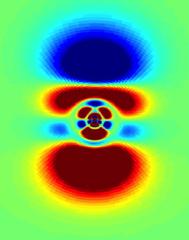URL: https://www.desy.de/news/news_search/index_eng.html
Breadcrumb Navigation
DESY News: Researchers unravel dynamics of electron clouds
News
News from the DESY research centre
Researchers unravel dynamics of electron clouds
A US-German research team has elucidated the ultra-fast dynamics of electron clouds in xenon atoms. Using attosecond technology, the scientists around Stephen R. Leone from the University of California in Berkeley were able to measure the reactions of the electrons to the strong field of an intense laser pulse in real time. Quantum mechanical modelling of the process by the team of DESY researcher Robin Santra from the Center for Free-Electron Laser Science (CFEL) provided the correct interpretation of the measurements. The physicists present their joint analysis in the journal Nature Physics.

"In the light pulse, the electric field oscillates with a period of a few femtoseconds," explains Santra, who is a lead scientist at DESY and a physics professor at the University of Hamburg. "With even faster attosecond technique, it was possible to track the reaction of the electron cloud during the oscillations." A femtosecond is a quadrillionth of a second, equivalent to one millionth of a thousandth of a microsecond. An attosecond (quintillionth of a second) is still a thousand times shorter.
Electrons are not only spatially displaced by electromagnetic fields, they can also absorb the energy of the field which puts them in an excited state. If the energy is high enough, the electrons can even get kicked out of their atom. Physicists call this process ionisation. Normally, for ionisation to happen the energy of the light must exceed a characteristic threshold depending on the type of atom. In quantum physics, however, a so-called tunnel effect can allow quantum objects like electrons to tunnel through an energy barrier. Through the tunnel effect, ionisation can occur even at an energy that is normally too low.
The scientists expected exactly this effect in their investigations of xenon. "In the experiment, however, there was a surprise: Although the xenon atoms were expected to be ionised by the tunnel effect, the quantum mechanical analysis showed that only a part of the so-called wave packet with which the electrons are described in quantum mechanics, is actually ionised," says Santra. "Another part is distorted by the oscillating electric field of the laser and always snaps back to its ground state when the oscillating field passes through zero. Just think of a spring that is periodically stretched and relaxed again."
This dichotomy between irreversible ionisation and reversible polarisation of the electron clouds can be understood in the context of quantum mechanics. "One might think that in a weak field the purely reversible process is present, while in the case of very strong fields the purely irreversible process prevails," Santra describes. "However, as we have shown, this clear separation does not exist."
Reference:
State-resolved attosecond reversible and irreversible dynamics in strong optical fields; Mazyar Sabbar, Henry Timmers, Yi-Jen Chen, Allison K. Pymer, Zhi-Heng Loh, Scott G. Sayres, Stefan Pabst, Robin Santra, Stephen R. Leone; Nature Physics, 2017; DOI: 10.1038/NPHYS4027



